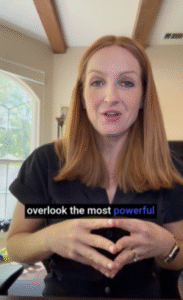A while back I wrote about the importance of laser focusing on who your audience really is. After all, in 2024, if you’re trying to speak to everyone, or even too broad of an audience, you’re really speaking to no one at all because your content automatically becomes general.
In an era where marketing experts at the University of San Diego tell us that we encounter 105,000 words a day, general messaging gets completely tuned out. (For comparison sake, you only speak between 8,000-20,000 words a day depending on your personality and gender).
Specificity in your messaging comes from defining your target audience (or ideal customer). Here are three tips for identifying your ideal customer and speaking to them directly so that you get noticed online.
1) Define your audience in one sentence. Before you create any piece of content, fill out the following sentence: I am writing (what) for (who) because (what do you want the who to do).
2) Get more specific. Once you define the “who”, force yourself to make that audience smaller at least twice. For example, if you’re starting with an audience of women between 25-44, you’re targeting an audience very similar to what many others are targeting online. So add some identifiers. Do these women have families? Do these women identify as a certain type of person (foodies, athletes, generational, etc.)? As you get specific with your audience you automatically will see your content get more specific. Try it. First, write a post to a general audience and then try again after you’ve added at least two descriptors. It’s fun to see your content change. Bonus: If you’re prompting AI, specifying your audience as much as you can will greatly improve the output of content you get.
3) Name your segment. Once you’ve found your segment, give them a name. Swifties did a brilliant job naming themselves as a fan base for Taylor Swift. If you are a Swiftie– rather than someone who goes to Taylor Swift concerts–you are identifying yourself as part of a group. See how the fan base who has a name is more active and simply describing the audience is more passive? It’s a subconscious, powerful, call to action. Test this by trying to tell a toddler to help you clean up versus asking them to “be my helper.” I promise you’ll have more success with the second scenario. Everyone wants to be a helper. Not as many people want to help (especially busy toddlers). This subtle difference goes a long way in creating effective CTAs (Calls to Action) among your ideal customers.
There are a plethora of other ways we can speak directly to our ideal customer to get noticed in a noisy world, but these three are my favorite places to start because they lay the foundation for the rest. Once you force yourself to define who you are trying to reach every time you put messaging online, whittle it down, and use action words to address them, you’ve created the first steps to form a brand community. In 2024, brand communities are essential in keeping your brand energized and authentic. Your ideal customer doesn’t just want to buy from you, they want to talk to each other about their pain points and they ways they overcome them (preferably with your brand in mind).
Who exactly are your ideal customers and what will you call them specifically? I’d love to hear at [email protected].











